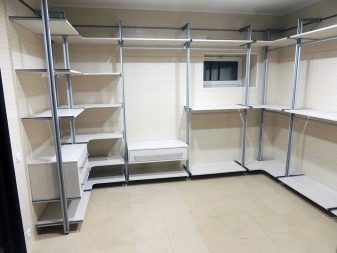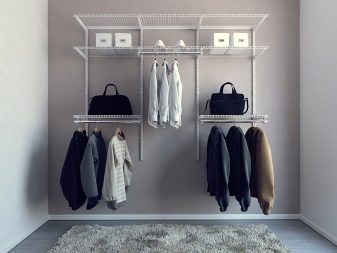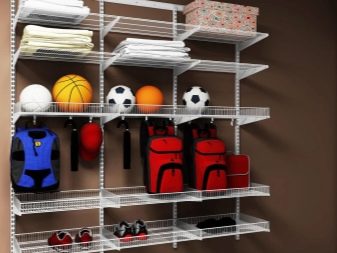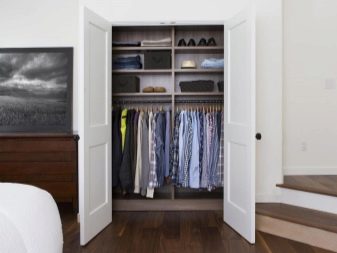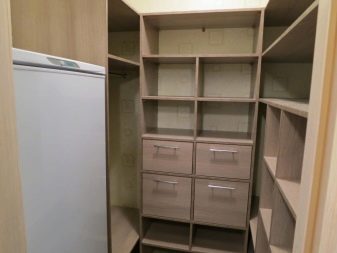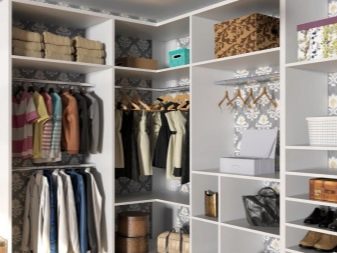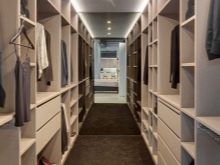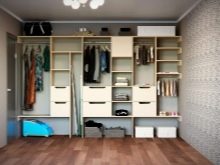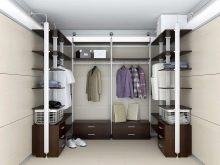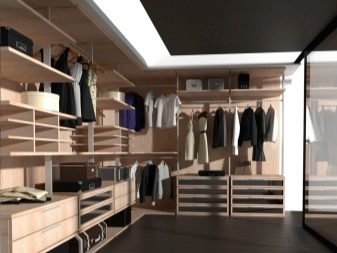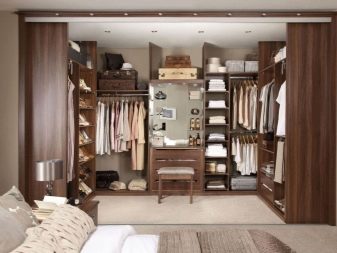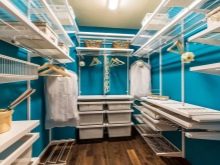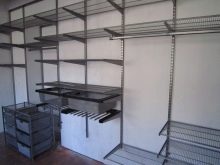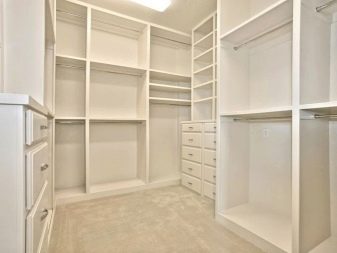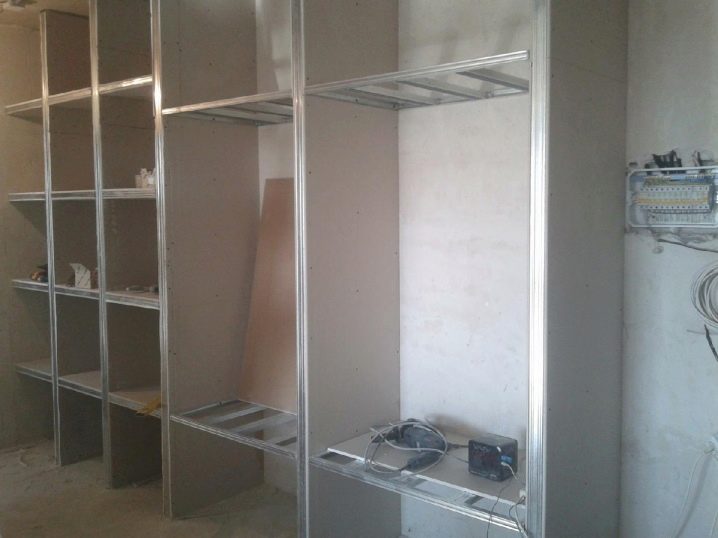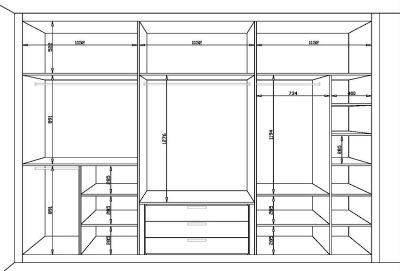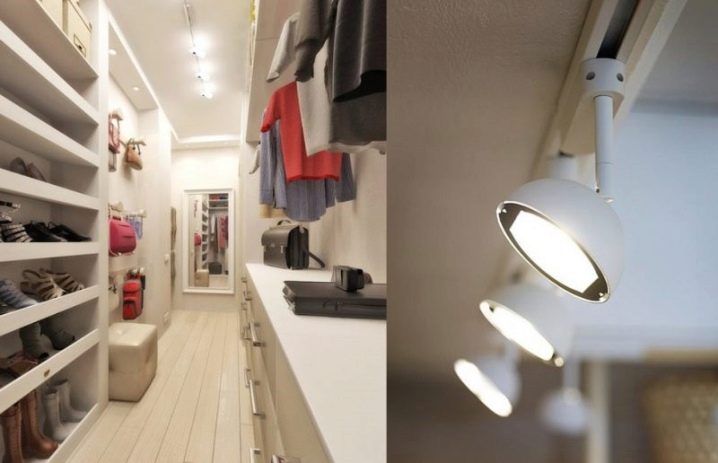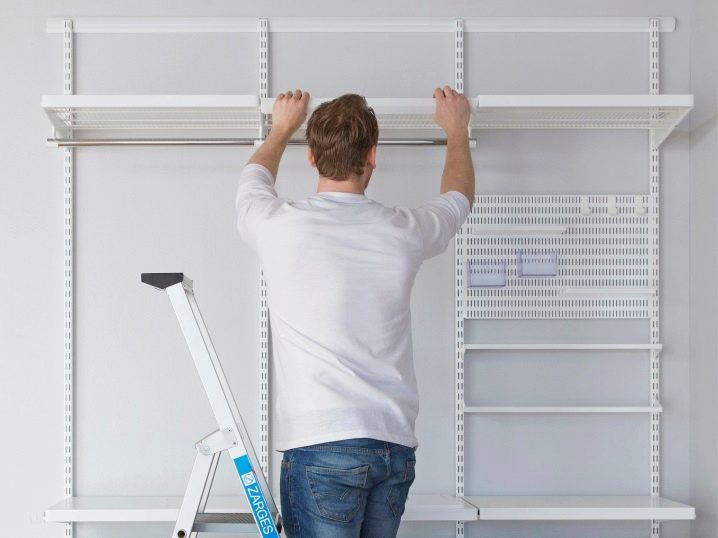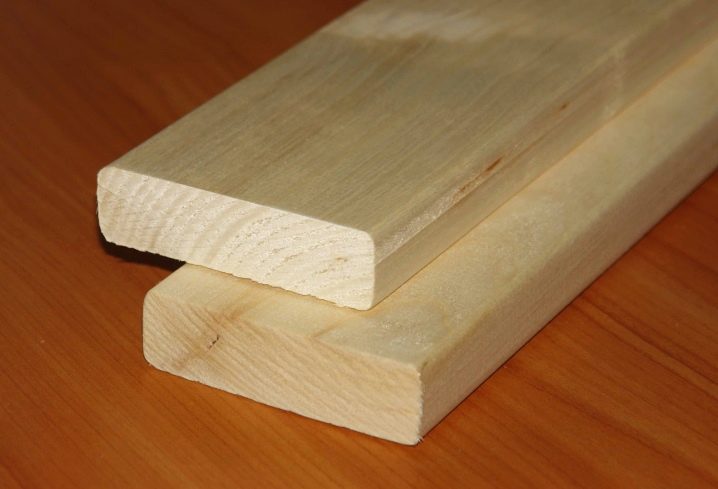Types of shelves for the dressing room and their placement
Among all the solutions that allow you to equip a dressing room, a special place is occupied by the installation of shelves. Their main advantages are simplicity and reliability, which are especially important for storing a large number of things. Also noteworthy are the many types of such structures, the correct placement of which allows you to achieve the best result.
Appointment
The purpose of creating any dressing room is the most convenient placement of clothes and shoes, as well as bags and other accessories.
Given this circumstance, a rational solution is to equip a racking system that will be not only functional, but also easy to use.
Such structures, which are racks with shelves, allow:
- keep things in perfect order, which means, find them with the least amount of time;
- use the available space with maximum efficiency, which is especially important for small spaces;
- fit seamlessly into the surrounding interior without overloading it - unlike large cabinets and bulky drawers.
In addition, the owner of the structure can use it in full accordance with his preferences - as an option, adhering to the following popular scheme:
- at the top - hats and seasonal items;
- below - shoes and bedding;
- in the central part - most of the clothes.
As for the side shelves, they are the best place to store small items.
Location options
Currently, apartments with a separate room for a dressing room are rare - as a rule, new buildings can boast of such a "bonus". Given this circumstance, home owners have to look for free space to accommodate shelf structures.
Alternatively, you can use a large niche or a pantry to equip a dressing room, depending on the layout of the apartment and personal preferences.
Do not despair also for those who cannot take advantage of the above recommendations. In their case, the shelves can be placed right in the room, allocating the least used space for them.
- At the junction of adjacent walls. Plasterboard sheets are best for differentiation.
- Along any of the blank walls. It is optimal to use a curtain or screen as a partition.
- The area behind the bed. To separate the dressing room, it is necessary to install a plasterboard false wall.
The most convenient placement of the entrance to the equipped room is from the bedroom side.
Alternative solutions allow the location of shelves in the corridor, hallway and even on the loggia. The latter option is acceptable, provided that the room is heated and combined with an adjoining room.
Special attention should be paid to the classification of dressing rooms, determined by the number and relative position of storage areas.
- 1-sided. The shelves are mounted along the selected side wall. The minimum free space for installation is 1.35 m wide.
- 2-sided. The racks are placed in parallel along two side walls. Arrangement is possible if there is a width of 1.5 m or more, 60 cm of which are left for the passage.
- 3-sided. The shelves are placed along two side walls and another one located between them. The key condition is the presence of 2 m wide.
A fourth option is also possible, involving the use of all walls of the room - including the one in which the doorway is located. It is important to take into account that such a solution requires a significant width - 2.4 m or more.
Views
Before proceeding with the arrangement of the dressing room, it is worth deciding on the type and number of structures mounted in it.
The solution to this problem must be approached responsibly, because it allows you to dispose of the available space with maximum efficiency.
Depending on the characteristics of the room and the wishes of the owner, a variety of types of shelves can be used: both stationary and pull-out, and combined.
Shelving
The version of the multi-tiered shelf, which is considered by many to be classic, has a built-in design. All elements of such racks are attached to adjacent surfaces: walls, ceiling and floor. This variety does not differ in intricacy - as an option, it may provide:
- use of laminated shelves for storing clothes;
- installation of lattice metal surfaces for shoes;
- installation of shelves using supporting frames, the material of which is a perforated profile.
Among the frame structures, the most popular are variations made of wood. They look very solid, and the overwhelming majority of those who wish can cope with their installation.
Prefabricated
This type of shelving involves the use of racks of different heights and shelves of different sizes. Such structures are collapsible, and their installation does not require a significant investment of time and effort - even when installing it yourself.
In most cases, the supports of such racks can be adjusted in height. This advantage is especially true for rooms that do not have a perfectly flat floor. To connect the shelves with the racks, special holders are provided, and the presence of the rear walls excludes the possibility of things tipping over.
Another feature of prefabricated structures is bolt-free connections. The shelves are mounted by means of hooks, and they can be fastened vertically, horizontally or "steps" in several levels.
Modular
There are several main reasons for installing modular shelving. In particular, they:
- can change places in accordance with the wishes of the owner of the premises;
- easily transformed, which allows you to create many options for arranging a dressing room;
- if necessary, they can be supplemented with auxiliary modules (typesetting storage systems allow you to create any new configurations);
- easy not only to install, but also to operate.
Thus, modular designs are rightfully considered one of the best solutions that guarantee ergonomic storage of wardrobe items.
Roll-out
The presented variety is the best option for narrow dressing rooms. Being high, such shelves resemble display cases, and their low variations have a lot in common with pull-out chests of drawers. It is also noteworthy that the installed withdrawable structures can be supplemented with auxiliary modules.
In order for the racks to last as long as possible, experts advise choosing models that are made of aluminum.
Separately, it is worth mentioning the use of roll-out shelves for storing shoes: their design allows products to be arranged in several rows and can be equipped with benches. The meaning of the latter is obvious - it is much easier to put on and off shoes with them than without them.
Materials (edit)
Today, multi-tiered wardrobe shelves are made from a number of popular materials.
- Wood. The key benefits are attractive appearance and natural origin. Cons - comparative "capriciousness" requiring special care, and the need to accurately calculate the maximum load. The design of wooden shelving can be either laconic or very pretentious, replete with a mass of decorative elements.
- Metal. One of the best materials for arranging shelves, the main advantages of which are practicality and durability. Also, metal products are distinguished by their reliability and ability to withstand significant loads. Mesh elements are rightfully considered the optimal solution for dressing rooms with variable air humidity, guaranteeing the best ventilation.
- MDF. Wear-resistant and environmentally friendly material, the surface of which is decorated with veneer or PVC foil. In addition, it is resistant to fluctuations in moisture levels and can withstand strong mechanical stress.
- Drywall. The main advantages are ease of processing and installation. It is important to take into account that, due to its fragility, this material is unsuitable for storing heavy things.
Another noteworthy solution is plastic. It does not belong to high-quality materials, but the shelves made from it can boast of cheapness, durability and many options for external performance.
Dimensions (edit)
As mentioned earlier, the standard dressing room design provides for three levels: lower (up to 60–80 cm), middle (from 60–80 to 190 cm) and upper (190 cm and more).
The last value is determined by the location of the ceiling, the distance to which should be relatively small - about 10 cm.
Other significant sizes are listed below.
- The depth of the middle segment should not be less than 50 cm. This is due to the fact that the width of standard clothes hangers is 45 cm. The optimal depth is around 60 cm. If the value is too large, it may be difficult to access the content.
- The recommended width of the inner shelves is 40 cm, while for mezzanines and compartments with hangers it should be twice as large.
- The depth of the compartments for storing shoes should be 40 cm. Practice shows that this value is sufficient in the vast majority of cases.
No less attention should be paid to the height of the compartments, determined by the specifics of their contents:
- shoes - from 20 to 45 cm (for low and high models, respectively);
- linen - from 15 to 20 cm;
- dresses and long outerwear - from 120 to 150 cm;
- trousers stored on hangers - from 140 to 150 cm;
- folded shirts and sweaters - from 30 to 40 cm;
- blouses and other underwear placed on hangers - from 110 to 120 cm.
As for the sections for pillows, blankets and other bulky items, their height should be in the region of 45-60 cm.
Backlight ideas
In order for the look of the dressing room to attract enthusiastic eyes, and the search for the right things was simple and convenient, it is worth paying attention to the organization of lighting. The solution to this problem involves taking into account the following simple rules:
- if there is no window in the dressing room, the light should be as close to natural as possible;
- the most suitable place for placing lamps is the ceiling of the room;
- in a situation where the dressing room has modest dimensions, it is rational to rely on point light sources or LED strips;
- it is justifiable to place chandeliers in rooms that do not suffer from a lack of free space;
- One of the best solutions for corner walk-in closets is clothespin lamps.
The main light sources can be supplemented with auxiliary ones, often performing a decorative function, for example: sconces or floor lamps. No less remarkable are the innovative solutions equipped with motion sensors.
How to fix it?
After all the elements are prepared (sawn out, sanded, varnished, etc.), you can start assembling the structure. The standard sequence of actions is as follows:
- make holes for fasteners using a drill of a suitable diameter;
- carefully check the accuracy of all horizontal lines;
- place the dowels in the holes provided for them, if the rack is attached directly to the wall (in the case of a wooden base, this step is skipped);
- securely fix furniture corners using self-tapping screws or confirmations;
- connect the mezzanine with the corners using small confirmations;
- hide all the hats of the fasteners under decorative overlays that have a suitable shade.
Also, some owners complement their shelves with doors. This option is quite acceptable - provided that the latter are made of glass or other transparent material.
How to do it yourself?
Not always ready-made shelves suit the owner of the dressing room.
The reason for this may be the non-standard dimensions of the latter, the desire to make the design special, or a simple desire to save money.
In such cases, you can make racks yourself, most often from soft woods - as one of the easiest materials to process.
It is important to remember here that:
- the boards used must be absolutely level;
- only dry wood without cracks, cavities and other defects is suitable for the manufacture of shelves;
- strong planed bars are used as a frame (the recommended section is 50x40 mm).
Upon completion of the preparation of the material, the owner of the premises must adhere to the following algorithm:
- cutting the surface using precise measuring tools;
- placing the material on a flat surface;
- neat sawing of boards along the outlined lines (if the shelves are shaped, you should use a jigsaw);
- processing the ends of each product with sandpaper of different grain size (first - coarse, then - fine);
- varnishing the surfaces of the shelves (after complete drying of the applied coating, the procedure is repeated);
- assembly of the structure according to the scheme described in the previous section.
In some cases, it is allowed to use wood with minor defects - provided they are carefully puttyed.
Following the recommendations listed above, anyone can equip their dressing room: both with ready-made shelves and made with their own hands. Accuracy, attentiveness and a little patience are all that are needed to accomplish this task.






